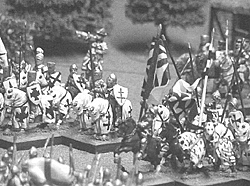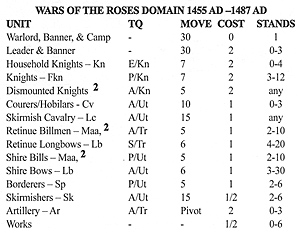
BATTLE PREPARATION
1. CAMPAIGN INITIATIVE
This simulates a limited operational campaign that has culminated in the battle to be fought. Each Warlord draws a randomizer card, adding his initiative to its value (SR+10.) Joker - you win. Ties are redrawn. SR 6/7 have an initiative of 16, SR 8 or higher equal an initiative of 17.
A. The higher score is considered the attacker and is the tactical campaign initiative winner. Ties are redrawn. The winner decides if he will fight on his domain’s territory (number of terrain features) or that of his enemy. The number of terrain features listed on each domain list simulates this simple campaign step. The domain that is chosen to campaign on will determine how many terrain features each Warlord draws and places on his side of the battlefield.
B. BATTLE LINES: As a Warlord deploys his units on the table; he must organize them into 1 or more battle lines. A Warlord must have a battle line for every banner in his army. All units (including hidden) must start deployed in a battle line. Once the battle begins a unit may leave its battle line.
BATTLE LINE MAKE UP
Warlord or Leader, his banner and banner unit.
Three or more units of any size.
Units in the battle line start deployed and in sight of and within 3” of the banner unit, or able to trace an uninterrupted line of friendly units (in good order) back to the banner unit. The facing of units doesn’t matter, but they must all be within 3” of each other. A disordered unit doesn’t connect other units to the battle line.
A disordered banner unit is the battle line and is therefore always in the battle line, but severs the tie as any unit would to others in the battle line.
Warlords and Leaders may leave their banner unit, which still exists without their presence.
C. BATTLEFIELD SIZE and DEPLOYMENT AREA
The size of the table is based on the starting points the players decided to use for the game.
10-50 AP per side are played on a 4’ square table. Troops may deploy on their half of the table, at least 12” from the centerline of the table. Formed troops may not start within 6” of either flank of the table.
51-75 AP per side are played on a 5’ x 6’ table with one additional terrain pick per side. Troops may deploy on their own half of the table, at least 12” from the centerline of the table. Formed troops may not start within 9” of either flank of the table.
76-100 AP per side are played on a 5’ x 8’ table with two additional terrain picks per side. Troops may deploy on their own half of the table, at least 12” from the centerline of the table. Formed troops may not start within 12” of either flank of the table.
101+ AP per side are played on a 5’ x 10’ table with three additional terrain picks per side. Troops may deploy on their own half of the table, at least 12” from the centerline of the table. Formed troops may not start within 15” of either flank of the table.
2. PLACE TERRAIN:
Warlord takes a new approach to terrain that allows a player to shape the terrain he will fight on. Gentle slope, area, obstacle, and impassable terrain features each have a total perimeter (or length) of 40. Players are free to choose the actual type of feature they are using. The rules provide the size and penalties.
A. CAMPS: These are 6” square and are area terrain.
B. Starting with the defender and alternating each draws for and places 1 terrain feature at a time until all terrain features are placed. Terrain features are usually deployed up to but no further than the Warlord’s centerline. Only skirmishers are allowed to start deployed within the dead zone of the flanks. *
3. DEPLOY WARLORDS and BANNER UNITS
After all terrain features are placed, the loser (followed by the winner) places himself, his camp, his banner unit, as well as any Leader’s and their banner units on the battlefield.
A. A Warlord’s banner unit is always the unit that costs the most AP in his army while a Leader’s banner unit is always the most expensive unit in his battle line. If there is a tie between units, it is the player’s choice. Banner units may not start hidden from view of the opposing force. They may start in terrain that would normally hide them but they are deemed to be visible due to their size, noise, and banners. They still gain any benefit that the terrain may provide. The Warlord’s camp must be deployed within 6” of his banner unit and in open or gentle hill terrain.
4. MARK HIDDEN UNITS
Each Warlord writes down on a map any units that will be deployed hidden. Hidden units must begin the battle within the army set on area.
5. TROOP DEPLOYMENT
Starting with the WL that lost the initiative, each deploys the balance of their visible units.
6. FIRST GAME MOVE INITIATIVE
At the start of a battle each Warlord draws a randomizer card and adds his initiative to it (SR +10). The player with the higher score decides who will take the first move of the battle. They then alternate play for the rest of the game. Jokers: you win. Ties are redrawn. SR 6/7 have an initiative of 16, SR 8 or higher equal an initiative of 17.
TURN SEQUENCE
COMMAND PHASE: Initiative check by personalities for command cards (SR +10.)
RALLY BROKEN UNITS (Morale.) *
CHECK FOR AND MOVE IMPETUOUS ADVANCES (See Morale.)
SHOOT. *R
DECLARE CHARGES. *
MOVE CHARGERS ONE MOVE.
MANEUVER AND MOVEMENT: Any units that wish to move are commanded to do so at this point in the game turn sequence. *
CHARGE REACTION: Determine and act on charge reaction. R
CLOSE TO CONTACT: Note that charges that start outside of shooting range are still eligible to be shot at!
MELEE.
POST MELEE MOVEMENT BY MELEE LOSER.
SHOOT. *R
Notes
- *: Requires a command to perform.
R: may trigger an uncontrolled reaction.

More Warlord Medieval Rules
Back to Table of Contents -- Courier # 83
To Courier List of Issues
To MagWeb Master Magazine List
© Copyright 2002 by The Courier Publishing Company.
This article appears in MagWeb (Magazine Web) on the Internet World Wide Web.
Other military history articles and gaming articles are available at http://www.magweb.com